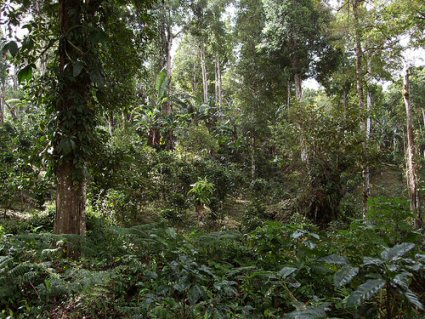
(Note: As of 2013 it appears that this coffee has been discontinued.)
The National Geographic Society is getting into the coffee business. They are rolling out a line of specialty-grade coffees called “Terra Firma.” They are all be single-origin coffees, from six countries: Brazil, Ethiopia, Sumatra, Kenya, Colombia, and Costa Rica. Net proceeds from Terra Firma coffee will support programs of the Society. Initially, it will only be available in the U.S., to both retail and food service users.
It’s not shade coffee
According to their press release, this coffee is “crafted to emphasize environmental and cultural sustainability in coffee-farming communities.” Further motivation apparently stemmed from results of a survey NatGeo contracted which indicated “being environmentally friendly” influenced the purchasing decisions of a majority of American. Yet although the coffees will be Fair Trade certified, none are certified organic or shade grown (Rainforest Alliance or Smithsonian Bird-Friendly). You’ll have to wait for one of those; there are plans to release an organic or Rainforest Alliance certified coffee in the future.
With all of Nat Geo’s emphasis on the environment, not to mention their long commitment to science, the lack of organic and/or shade certification for the Terra Firma coffees is bound to stick in the craw of educated consumers. The press release states that Fair Trade certification “guarantees…environmental stewardship,” which it does not.
On the plus side, at least we know who is roasting their coffee.
The Terra Firma coffee will be sourced and roasted by the Brazilian firm Café Bom Dia. Americans perhaps best know them as the source of the coffee sold at Sam’s Club and WalMart under the Member’s Mark and Marques de Paiva brands.
Since I last wrote about Café Bom Dia, their web site has had an overhaul and there is additional information about their sustainability efforts, which are certainly the most impressive of any of the large coffee roasters. Their main roasting facility is in Varginha, Minas Gerias, Brazil, where the roasters run on biomass (“sustainably forested eucalyptus” and wood from coffee trees taken out of production). This facility has zero net carbon emissions and is certified CarbonNeutral. This is where the Terra Firma coffee will be roasted.
Specific sources
Café Bom Dia owns and manages farms in Brazil, but also has a network of 4800 producers in all the Terra Firma countries of origin except for Kenya, which will be a new relationship for Café Bom Dia. Because large plantations and family-owned farms do not qualify for Fair Trade status, the Brazilian beans will not come from Café om Dia farms, but from Fair Trade cooperatives in southern Minas Gerias. The specific sources for the beans from other origins will depend on harvests and availability — the usual criteria for large-volume efforts that depend on a particular flavor profile and price point. I was told by that for this initial line of Fair Trade coffees, source cooperatives will not be chosen specifically for their environmental practices.
National Geographic drops the ball
I obviously have a preference for (and encourage people to seek out) coffee in which the specific origins — and therefore growing methods — can be easily traced and explored. In my opinion, the problem with the Terra Firma coffee isn’t that NatGeo partnered with Café Bom Dia. In fact, I commend Café Bom Dia for always being responsive and straightforward with me, and for what I believe to be a more sincere effort to run an eco-friendly business than any other large roaster. Café Bom Dia can and does source organic and Rainforest Alliance certified coffees — it’s what they sell at Sam’s Clubs and WalMart, where their Rainforest Alliance coffees are even 100% certified beans. What is remarkable is National Geographic did not choose these sustainable coffees for their initial offerings.

In preparing this post, I first wrote to Café Bom Dia with questions about this choice. Café Bom Dia provided much of the information above, including the fact that organic or RA certified selections were planned for the future. I followed up with NatGeo specifically asking about the choice not to initially include more eco-friendly selections. Here is their reply:
While you do raise some interesting questions, we have to defer to Café Bom Dia on the finer points of their coffee production methods.
In keeping with our mission to “inspire people to care about the planet,” we do our best to promote sustainability through our mission-oriented projects, editorial endeavors and licensed products. There are many factors that are taken into account when choosing a new partner: we chose Café Bom Dia because of the company’s commitment to sustainability and its pedigree as a certified Fair Trade supplier.
In recent years, NatGeo has licensed their brand on a wide range of disparate products, including digital music, apparel, and home furniture. Given the serious impacts of coffee growing on the environment, coffee seems like a better fit than many of the other items that display the NatGeo logo. It presents a fantastic educational opportunity — the power of National Geographic to inform consumers about coffee sustainability issues is tremendous. The Society has 8.5 million members, but its reach and respect go far beyond those numbers. It would have sent a strong message if they had chosen to market and promote certified, eco-friendly coffees. Actually, the fact that they did not sends an equally strong one.













